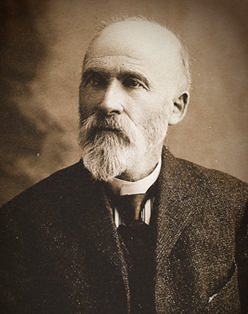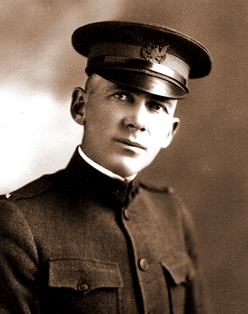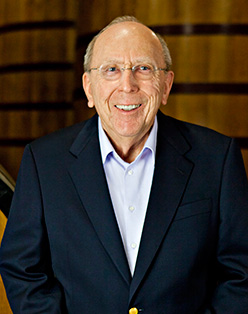Four Generations of Wine Pioneers
Meet the Concannon mavericks whose vision, determination and
unconventional wisdom have made Concannon what it is today.
-

James Concannon
Founder -

Captain Joe Concannon
Second Generation -

Jim Concannon
Third Generation -

John Concannon
Fourth Generation
James
In 1883, James Concannon not only established the first successful winery founded by an Irish immigrant, but also established Concannon as a Founding Family of the California Wine Industry. Recognizing that the Livermore Valley terroir was strikingly similar to the premier vineyards of the Médoc in Bordeaux, he purchased our beautiful acreage where he helped introduce successful viticulture practices for the first time to California. After intense study of winegrowing in Bordeaux and with UC Berkeley, James became one of the first to craft red and white Bordeaux-style wines in California and was well-known for his meticulous selection of the world’s best quality vines imported directly from Bordeaux’s renowned, First Growth Châteaux Margaux, Lafite and d’Yquem. Convinced that California could become as great a winemaking region as Bordeaux, he also believed strongly in the cultural benefits of wine. As a result, James was one of a small group of wine pioneers who introduced high quality wine for the first time to the American table. Of James, the famous author, Seumas MacManus, wrote that his was “a lifetime of remarkable action and remarkable progress” and that “Honor was his guiding star.”
Capt. Joe
After serving in the U.S. Calvary under Gen. John Pershing and Lt. George Patton, James’ son, Capt. Joe, returned home to lead the winery. A visionary winemaker and staunch defender of freedom, he also led in the anti-Prohibition movement; and, then during Prohibition, it was Capt. Joe who kept Concannon continuously open and operating as one of only a select few wineries licensed to make, bottle and sell sacramental wine under its own family label. As a result, Capt. Joe protected Concannon’s treasured Bordeaux and European vines which he believed would one day serve well in re-establishing a thriving California wine region. Also during Prohibition, Capt. Joe introduced America’s first varietal wine label with his 1922 and 1925 bottled Rieslings. In the 1920s, he was also a first to bottle red Zinfandel and Cabernet Sauvignon as varietal wines. Prepared and ready to help re-introduce high quality wine to the American table, at Repeal, Capt. Joe was first in shipping fine wines to Seattle and many cities, coast-to-coast. In 1934, he became a founding member of the Wine Institute to help reintroduce best winegrowing practices and rebuild a successful California wine industry. Later, his friend, André Tchelistcheff, “the dean of American winemakers,” credited Capt. Joe with having first described to him the scent that would guide him to the perfect Pinot Noir, thus setting the benchmark for California Pinot Noir.
Jim
Awarded the California State Fair’s prestigious “Lifetime Achievement Award,” and named “Man of the Year” by Tasting Panel Magazine, Jim Concannon has garnered profound respect as one of the most honored wine pioneers of the California wine industry. In 1960, Jim became third generation vintner at a time when California wine was unnoticed worldwide. Believing in California’s unparalleled potential to become a leading wine region, he was an avid supporter of UC Davis’ clonal selection program in collecting the best, most productive vines for supplying to growers for making better wines. Hoping to develop Cabernet clones benefiting all California winemaking, in 1965, he collaborated with Dr. Harold Olmo and Curt Alley of UC Davis in developing the Concannon Cabernet Clones 7, 8, 11 from a single vine propagated from extraordinary Cabernet that his grandfather, James, had imported from Château Margaux in 1893.
The Concannon Clones quickly became the industry standard. Then, at the 1976 Judgment of Paris, California Cabernet stunned the world by winning first over France’s four top-ranked, red Bordeaux. With California winegrowers’ new confidence and excitement for growing Cabernet, the Concannon Clones quickly became an essential asset to the enormous expansion of Cabernet plantings that ensued. Today, an estimated 80% of California’s 90,000 acres of Cabernet are planted to the Concannon Clones. And, according to Dr. Deborah Golino, Director of FPS at UC Davis: “In this day and age, there’s an explosion of clones, but the solid clones that built the Cabernet industry in California are the Concannon Clones.”
Jim also helped change the landscape of California wine history with his 1964 introduction of “America’s First Petite Sirah” from his 1961 vintage. Before that time, Petite Sirah was used only as a blending grape in winemaking; however, Jim recognized this luscious variety’s wonderful potential as a varietal wine. Jim is now affectionately known as the “Father of the Concannon Clones” and the “Father of Petite Sirah.”
John
John Concannon is the Fourth Generation Vintner. Always with an eye on the future, John believed that continuing his family’s legacy of innovation is key to long-term success and definitive of who Concannon is as a family and winery. As a strong advocate of environmental stewardship, John is especially proud that Concannon was one of the first seventeen wineries in California to become Certified Sustainable. Also under his watch, Concannon completed a ten-year, revitalization project which includes a new, high-end, solar-powered, production facility and state-of-the-art, small lot winery along with the restoration of the original, historic winery and barrel room. As a strong advocate of viticultural research and education, John was honored to present, “The Concannon Cabernet Clones 7, 8, 11” as a keynote speaker at the 2014 International Cabernet Symposium. And, from John’s close work with The Smithsonian, three extremely rare, Concannon Prohibition-dated bottles are now at home in the National Museum of American History, Smithsonian collection. These same bottles can now also be viewed along with vintage 19th and 20th century, Concannon and California wine pioneer photos in the Concannon History Gallery that John dedicated to his father, Jim, at the family’s 1883 winery.
Some of John’s most energetic endeavors have also been focused upon preserving the landmark estate’s extraordinary sense of place by creating an exceptional winery experience for guests. As a result, Concannon is now recognized by USA Today Travel and other national publications as a top wine country destination. Like those who led before him, John is committed to working toward the overall success of the California wine industry.
